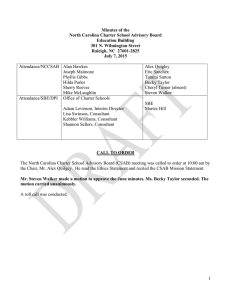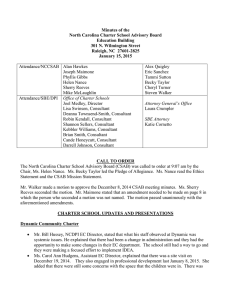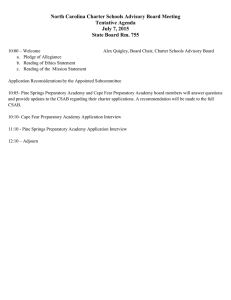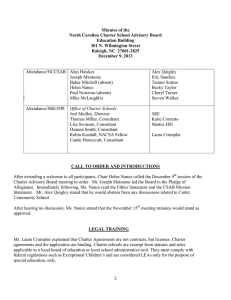Minutes of the North Carolina Charter School Advisory Board Education Building
advertisement
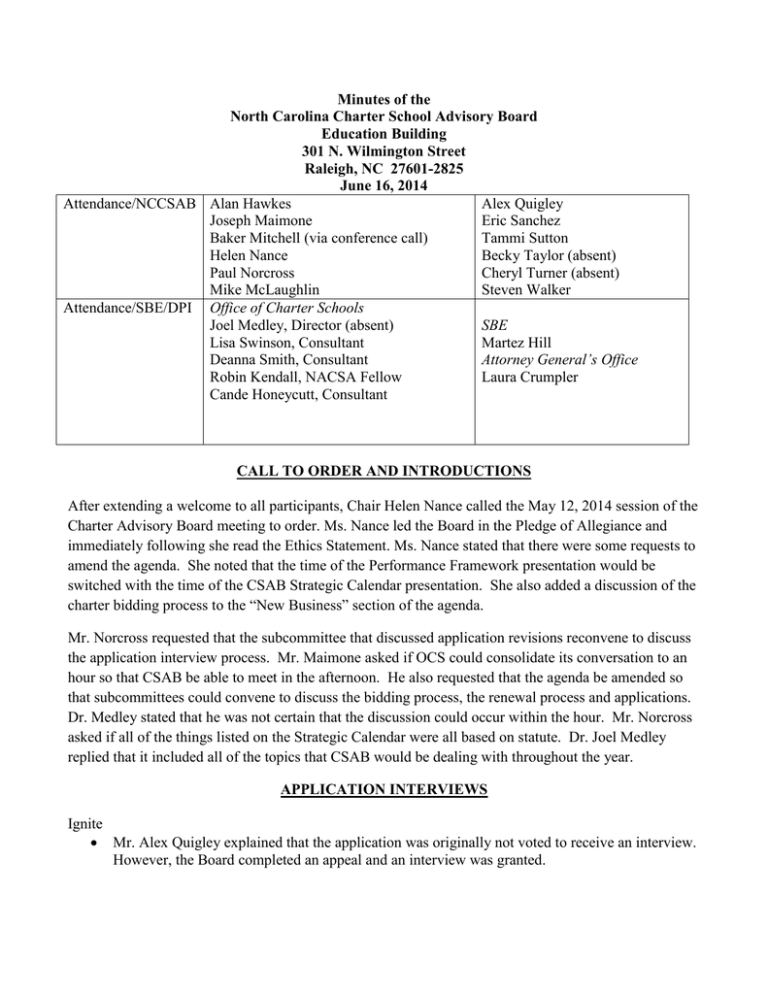
Minutes of the North Carolina Charter School Advisory Board Education Building 301 N. Wilmington Street Raleigh, NC 27601-2825 June 16, 2014 Attendance/NCCSAB Alan Hawkes Alex Quigley Joseph Maimone Eric Sanchez Baker Mitchell (via conference call) Tammi Sutton Helen Nance Becky Taylor (absent) Paul Norcross Cheryl Turner (absent) Mike McLaughlin Steven Walker Attendance/SBE/DPI Office of Charter Schools Joel Medley, Director (absent) SBE Lisa Swinson, Consultant Martez Hill Deanna Smith, Consultant Attorney General’s Office Robin Kendall, NACSA Fellow Laura Crumpler Cande Honeycutt, Consultant CALL TO ORDER AND INTRODUCTIONS After extending a welcome to all participants, Chair Helen Nance called the May 12, 2014 session of the Charter Advisory Board meeting to order. Ms. Nance led the Board in the Pledge of Allegiance and immediately following she read the Ethics Statement. Ms. Nance stated that there were some requests to amend the agenda. She noted that the time of the Performance Framework presentation would be switched with the time of the CSAB Strategic Calendar presentation. She also added a discussion of the charter bidding process to the “New Business” section of the agenda. Mr. Norcross requested that the subcommittee that discussed application revisions reconvene to discuss the application interview process. Mr. Maimone asked if OCS could consolidate its conversation to an hour so that CSAB be able to meet in the afternoon. He also requested that the agenda be amended so that subcommittees could convene to discuss the bidding process, the renewal process and applications. Dr. Medley stated that he was not certain that the discussion could occur within the hour. Mr. Norcross asked if all of the things listed on the Strategic Calendar were all based on statute. Dr. Joel Medley replied that it included all of the topics that CSAB would be dealing with throughout the year. APPLICATION INTERVIEWS Ignite Mr. Alex Quigley explained that the application was originally not voted to receive an interview. However, the Board completed an appeal and an interview was granted. Mr. Quigley asked for further information about blended learning. The applicants responded that there would be a rotation of blocks in each class using Core Knowledge. Each rotation will have a component where the teacher leads and there would be eighteen students in each class. Ms. Nance asked if the students would stay in the same classroom or rotate. The applicants responded that students in grades K-5 would stay in the same classroom but in middle school the format would be different. The curriculum will be led by Goal Book in which each student would have a Personal Education Plan. There will be twenty hours plus of professional development and it will take a lot of education preparing teachers. It will take special teachers to implement the blended learning curriculum. Mr. Quigley asked about the programs that would be used. The applicant responded that Kahn Academy would be used, as well as, Goal Book. Parents would be able to log in and track the progress. The computer is going to reinforce the core information and establish whether the child has mastered it by assessing. It will be an interactive process. Mr. Quigley asked if the Board would be contracting with Ignite. The Board responded that they would after a bidding process. Ignite would provide all of the technical support. Mr. Quigley asked about the school’s discipline policy. The applicants responded that the YEAH! program encourages leadership skills in children early on. It goes back to enforcing the school’s mission. In terms of discipline it is grabbing from the leadership model. The program will allow the students to look at their core qualities and this would develop a sense of community among the students. Mr. Quigley stated that there was only one Exceptional Children’s (EC) staff person for 218 students. The applicants responded that the master teachers would be required to be EC qualified and the assistants would also be EC qualified. The number would grow as the need grows. Goal Book would help to support a team approach. Mr. Quigley asked how the EC students would be identified. The applicants responded that it would be from prior school recognition, parent referral, and the Goal Book software. Mr. Quigley inquired about the number of Board members and why they wanted to create a blended learning program. The applicants responded that there were five Board members. The board chair stated that he wanted to see passion in children that would not be lost. The hope is to keep the students attention so that they were excited about learning and the rotations would keep their interest. Mr. Quigley asked how the school would transition the students to high school in which they would not be rotating. The applicants responded that within Pitt County, there was a tight knit community. Pitt County schools are using a lot of technology programs and the transition would be easy. The data from other blended learning schools in California, New York, and Washington drives the decision because the accomplishment of the students were impressive. The goal is to hit 60% the first year. Mr. Quigley noted that the governance structure was confusing. The applicants referred to a document that was provided to the CSAB and explained that the person on the advisory board would report to the Board. The other advisory board would report to the Executive Director. Ignite would be on the technical advisory board that would report to the Executive Director. Mr. Quigley stated that the budget expenditures seemed too low. The applicants responded that those where quotes that they received with the total technology package of $23,000 Mr. Quigley asked about the break even number. The applicants responded that there would be a surplus of $31,000. If there are fewer students there would have to be fewer teachers. The number of students drives everything. Mr. Quigley responded that $31,000 is small for a surplus. Ms. Nance asked if the Board thought about where they could go to get additional funds. The applicant responded that they had not thought about that. Most students would be coming from Pitt County and private schools do well in Pitt County. Mr. Maimone asked about the responses from the community. The applicants responded that they rely heavily on social media and there has been a good response. Mr. Quigley asked what percent of low income students they were looking at. The applicants responded that the numbers were representative of Pitt County and they were not aware of that number. CSAB Discussion: Ms. Nance stated that the education plan lended itself to high school. The structure of the classes would lend itself to a combination class if there were low numbers. The real trick with any program is teacher program. Mr. Maimone made a motion to forward Ignite to the Ready to Open status. Mr. Norcross seconded. Mr. Quigley commented that the school is a good idea and they were partnering with a group that had already had success. Mr. Quigley suggested that the Board redo their enrollment numbers so that the budget would work better. The motion passed unanimously. PERFORMANCE FRAMEWORK Ms. Robin Kendall presented a PowerPoint that explained the rationale for the Performance Framework. She explained that the Academic and Financial components were the drivers of the decisions that CSAB had to make. Dr. Medley commented that the Academic component was to be determined. OCS would be having meetings with charter school administrators to talk through the academic component. Ms. Kendall explained that the Operational Framework would focus on six main components. Mr. Norcross asked if the Performance Framework was in statute. Ms. Kendall responded that it was a SBE Strategic Goal. Mr. Hawkes asked if it was a reaction of Student First failing. Dr. Medley replied that the conversation began prior to Student First’s implosion. The purpose of the Framework is to establish clear standards for all school and it will serves as an early intervention for schools to use their autonomy. Dr. Medley stated that CSAB did not have to approve the Performance Framework. Mr. Maimone asked why the checklist that was created by the Charter Advisory Board could not be used. Dr. Medley replied that this process is more robust. Ms. Nance noted that the school does not have to gather this information because the work will be done by OCS and other DPI departments. Ms. Kendell explained that the next steps were for the CSAB to provide feedback by July 2, 2104 for the Performance Framework. Ms. Alexis Schauss addressed the Financial Performance Framework. She stated that there was financial compliance and financial health and sometimes they are related and sometimes they are not. The state is required to monitor on a consistent basis. When schools are put on noncompliance status, they must complete an action plan and come in for a meeting with OCS. Ms. Schauss commented that the document was a worthwhile and there was a compliance side to charter schools. Mr. Mitchell commented that the LGC audit already provides all of that information and it seems to be duplicative because there is a huge amount of investigation that goes into the audit. Ms. Schauss responded that the audits that are done by independent auditors have their own compliances that are industry related. Finance and Business does not have staff to go out to all of the schools. The audits are required by law and are a more efficient way to get information to DPI. She agreed that the audits were labor intensive by the client. Their opinion statements are industry based. Dr. Medley commented that SBE has asked OCS to make the Framework happen. OCS will be modifying the site visits protocol to align with the Framework. Charter schools are getting a lot of attention and it is important to look for quality. We will look at the information differently than the auditors. STRATEGIC CALENDAR Dr. Deanna Townsend-Smith explained that the Strategic Calendar was created based on lessons learned and things that happen in OCS by a month-to-month basis. The strategic calendar was a draft and CSAB could add items to the calendar. The calendar reflected one day per month that CSAB would meet. The dates follow the trend of meeting a week after CSAB. RENEWAL PROCESS Ms. Lisa Swinson presented information about the renewal process to the CSAB. She explained that explained that the recommendations for renewal that were presented to would go into effect after the current renewal cycle. o She explained that because the Performance Framework would capture a lot of the data from each school, the Renewal Self-Study document would be more simplified and be more reflective of the school’s mission. Mr. Maimone stated he was in favor of a more simplified Self-Study. o Mr. Walker proposed that a committee be formed to discuss the Renewal because there was a proposed bill that would give a ten year default for renewals. He proposed that he chair the committee. Ms. Nance suggested that the CSAB come up with a product to present that may drive the legislative decision. Mr. Walker mad a motion to table the charter renewal discussion. Mr. Norcross seconded. o Ms. Nance proposed that the CSAB take action instead of discussion in subcommittee as legislation was moving much quicker. Dr. Medley added that OCS still would have to move forward because we do not have the flexibility to wait. o Mr. Walker reiterated the need for continued discussion and development in a subcommittee. o Mr. Quigley stated that it would be simpler and more manageable to take out the 7 year renewal and only have a 3, 5, 10 year terms with stipulations for the third year. o Ms. Swinson sought further clarification on the purpose of the subcommittee. Mr. Walker replied that it would allow time for a decision to be voted on by the legislature. o Dr. Medley stated that the information that was before CSAB would be used by OCS to make recommendations to the CSAB and to outline expectations to the school from the beginning. The motion carried 4-3 with Ms. Nance, Mr. Maimone and Mr. Quigley dissenting. o Ms. Nance made a motion to accept the revised Renewal Self-Study. Mr. Maimone seconded. The motion passed unanimously. KESTREL HEIGHTS Dr. Medley provided an updated to CSAB concerning Kestrel Height's renewal status. He explained that the school was been placed on a governance warning. The advisory board made a recommendation that they receive a 5 year instead of a 3 year if there were any noncompliance issues at the end of the school year. The board chair understood that the recommendation had to be made and the matter would be going before the SBE during their next session. READY TO OPEN REPORT Dr. Kebbler Williams provided an update to the Ready to Open Process. She explained the four different categories that schools were placed in. Dr. Williams explained that 8 of the 27 schools were placed in the “slight progress” category in which it would be required that the Board meets with OCS and a member of CSAB. Mr. Maimone asked for clarification on the missing documents. Dr. Williams replied that some schools were missing enrollment, budget, policies and governance documents. Mr. Quigley noted that Entrepreneur was in the “slight progress” category but had also come before the board with governance issues. Dr. Miller replied that the concerns were with required reporting. They have been given 30 additional days. They are at capacity for applications but not for grade level structure. Additionally, there was a lack of governance exercises. Mr. Walker asked if the policies could be fixed in a Board meeting or if they will have problems getting open. Dr. Miller replied that there were no draft policies that were provided. Ms. Nance asked what the consequences were for schools that are not ready. Dr. Miller replied that the majority of the schools had taken the checklist and had done well with it. Dr. Medley replied that there may be a delay for some of these schools that would go before the SBE. Mr. Maimone asked if there were any of the schools that have concerns with enrollment. Dr. Williams explained that there were three schools with enrollment concerns and the Boards have a plan in place to boost their enrollment. Mr. Walker asked if an update on the school’s present enrollment could be provided to the CSAB. THE BIDDING PROCESS Dr. Medley stated that DPI’s CFO was currently looking at the bidding process. He explained that the CFO really wanted to be highly involved in the process and he planned to make a presented to SBE in August. Ms. Nance stated that she would establish a subcommittee that would work with DPI CFO. REPLICATION SUBCOMMITTEE REPORT Ms. Tammi Sutton stated that the replication subcommittee was planning to meet again to add clarity for organizations that are about to apply. The subcommittee was discussing the process for 2 situations. One of the major points is that anyone who applies for a charter must be completely transparent about what it written in the charter. The replication subcommittee will meet next Monday at 1:00 pm with the full CSAB at 3:00 pm. Mr. Sanchez suggested that the CSAB discuss the renewal process. Mr. Walker stated that he would like to wait to make decisions about the process. Mr. Sanchez added that the CSAB was making decisions about each school without guidelines. Mr. Quigley asked for a summary of the proposed legislature related to the renewal process. Dr. Medley responded and added that OCS would continue with the current process. Mr. Walker made a motion to adjourn. Mr. Norcross seconded. Ms. Nance stated that over half of the board is a new board and that one of the things that CSAB should be trying to do is help to create quality schools. CSAB are stewards of the tax payer’s money. Mr. Hawkes stated that he would like to start on time. Mr. Maimone replied that he would appreciate the time that we meet with subcommittees to get as much done in the time. Ms. Nance stated that CSAB would not go into subcommittees because the subcommittees were not noticed. The meeting adjourned.

